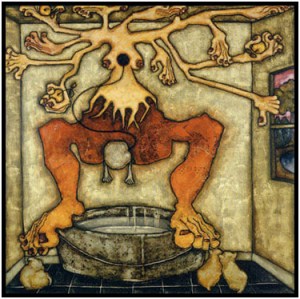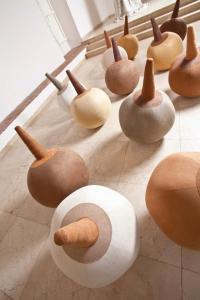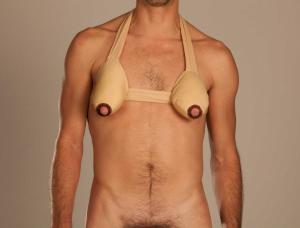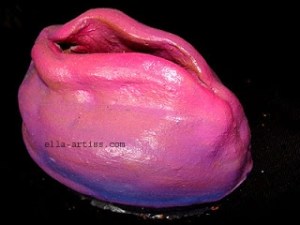Representing the human body has always been preponderant in the Fine Arts. In Painting, Sculpture, Photography it has become a privileged subject. Among all the graphic or pictorial evocations, nudity is the most common genre in Western painting, sometimes linked to memorable scandals if one thinks of paintings such as Edouard Manet’s Olympia (1863) and Déjeuner sur l’herbe /The Luncheon on the Grass (1863). A few decades later, the nude photos by painter and sculptor Abelardo Rodriguèz Urdaneta will cause some scandal in the conventional, uptight and very religious society of the Dominican Republic, just as in the 1920’s the nude mulatto women of Celeste Woss y Gil will do.
From the 1960’s, the body was not exclusively limited to a status of representation, on the contrary it became used as a prop for protest, a communication tool for ideals and claims, a provocation vehicle defending the freedom of speech
The body becomes among other things a tool for the feminist protest with artists like Orlan, Valie Export, Louise Bourgeois, The Guerilla Girls, Kara Walker, Marina Amabrovic, and Annette Messager.
This artistic work based on protest is also common in the Caribbean even though it seems less obvious in the French oversea regions of America. If we consider a broader context, that of the Caribbean, numerous works directly related to women’s menstruation, feminist protest or confusion of genders can be found.
So in the first category of works related to menstruation we can evoke Suzan Dayal (Trinidad) with Menstruation/Ovulation (acrylic on canvas, cotton, linen, bamboo and iron sheet, (158cm x158cm) and also Raquel Païewonsky (Dominican Republic) featuring pregnancy and maternity.
Women artists like Joscelyn Gardner (Barbados) Raquel Païewonsky (Dominican Republic) Suzan Dayal (Trinidad) Janine Antoni (Bahamas) Nicole Awaï (Trinidad) also question feminist issues.
Joscelyn Gardner deals with women’s condition during slavery as victims of a patriarchal system and of their master’s violence in her installations entitled The Merkin Poker or A Creole Conversation Piece.
Breasts are a recurring shape in Raquel Païewonsky’s work, in her paintings as well as in her installations. The title Bitch Ball is a pun on the words bitch and beach. Païewonsky questions the nursing mother/ sex toy representation but also the representation that society- and women too- gives to the feminine body, of feminity. These are oversized breasts with oversized areola and nipple, which are hand embroidered, fitted over huge beach balls covered in microfiber, a synthetic material similar to the human skin and representing different shades of skin colour that can be found in the Caribbean.
Photographed by Noritoshi Hirakawa as Beauty Queen as a Pin-up in the Big River workshop in Trinidad in 1999, Suzan Dayal’s demonstration aims at demanding respect for all women whatever their appearance. It doesn’t matter how I look, I deserve your respect –Say no to objectification- Is this what feminists fought for?’
Janine Antoni’s performance, Loving Care (1993) denounces society’s violent pressure and beauty standards on women just like the series These Cages Cannot Hold Us by Suzan Dayal (2004). It would be much too long to list all the works.
On an international level, we can quote Louise Bougeois, Orlan, Valie Export, Marina Amabrovic, Kara Walker, and The Guerilla Girls.
Trans-sicion by Leticia Ceballos, just like One by Raquel Païewonski both artists from the Dominican Republic, or else, Hustle de Money- A Performance by Bertie aka Big Red aka De General outta Glitter by Alberta Whittle (Barbados) focus on the genre thematic, whereas Yeni and Nan, between 1978 and 1986 are the first women artists from Venezuela to use their own body in performances set in wild nature.
I don’t think that we could confirm that in Martinique there exists a strong tradition, or a movement of women artists who produce committed and radical work about the feminist thematic.
Some artists have indeed created either on their own or punctually works that could be related to feminine practice or the problematic of gender confusion even though these issues were not actually at the core of their practice.
I can mention more particularly Julie Bessard’s work (Martinique) whose Ombres portées – Projected Shadows- are not based on feminism. She creates installations using the straw with which the milliner makes hats. First the preparation of the straw which is fixed with staples on a hard thread to make it easier to bend it and then shaping it into the object she wants is a long painstaking work, expiatory, partly like saying the rosary or working at a tapestry. This is a repetitive and automatic gesture in which the artist’s entire body is needed, and we could probably make a parallel with Joscelyn Gardner’s Tiny Prick – (Barbados), or even classify this among the practices most commonly defined as specifically feminine. All the same can we relate the artist’s sex with her creative choices? The dolls created by Alex Burke (Martinique) as well as the paper lace of Marlon Griffith (The Bahamas) seem to denote the opposite.
When in 1990 Jacqueline Fabien (Martinique) paints Nus endormis -Nudes Asleep– sweetly curved masculine bodies lying next to more muscular feminine bodies, she does indeed deal with the gender issue even if basically her reflection in this series centers on the relationship between the painter and her model.
Today, Shirley Rufin (Martinique) currently veils/unveils naked feminine or masculine bodies in her experimental photos. However, her approach is not a feminist stance but rather the taboo about nudity and how to overcome it.
In the same way, Ella-artiss (Martinique) works in an intimate sort of reconciliation with her own body, a process that avoids aggressiveness, a process of re-appropriation of a personal image, positive and confident in her sex so as to fight against debasing attitudes.
A young artist deals more directly with the feminist theme: The installationVagina by Kelly Sinnapah Mary (Guadeloupe) suggests a reflection about the symbolical violence against women and questions the hyper-sexualized aspect of the relationship man/woman as well as their respective parts in the household.
What dialogue can be established between the glorified nudes by Céleste Woss y Gil (Dominican Republic), or the narrative photographic mise-en-scène by Renée Cox (Jamaica), the feminist performances by Janine Antoni (Bahamas) or Ana Mendieta (Cuba), social or historical critique that we find in the fragmented bodies of Raquel Païewonsky (Dominican Republic) or Joscelyn Gardner (Barbados)?
Dominique Brebion
Traduction Suzanne Lampla










Dominique – you are doing an awesome job with this website! Congrats and I PROMISE to send you something soon!
Publié par Allison | 4 août 2013, 12 h 46 min